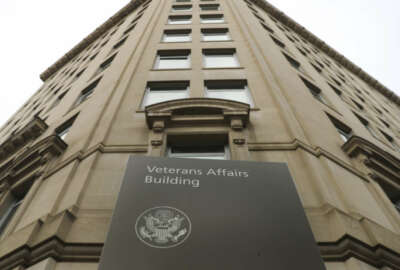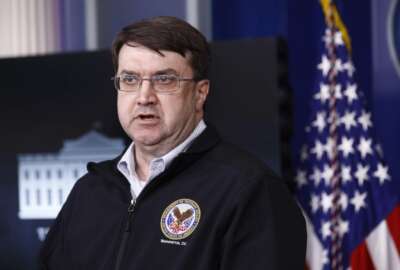
Veterans Affairs campuses are designed to open. Maybe too open.
The Veterans Affairs Department's big medical campuses are full of physical security gaps, the VA's office of Inspector General has found. Unlocked exterior doors,...
The Veterans Affairs Department’s big medical campuses are full of physical security gaps, the VA’s office of Inspector General has found. Unlocked exterior doors, broken surveillance cameras and a shortage of VA police officers top the list. For details, the Federal Drive with Tom Temin spoke with Deputy Assistant Inspector General Leigh Ann Searight.
Interview transcript:
Tom Temin What prompted a look at physical security of VA facilities? And these are often very large campuses, aren’t they?
Leigh Ann Searight Right. So given the growing concerns about facility security, we initiated this review to provide VA leaders with a snapshot of on the ground security conditions at their medical facilities. There’s over 171 medical campuses across the United States, and each of those are open campuses, people coming and going and streets running right in front of them. So I’m in the middle of a major metropolitan area. So we wanted to take a look at those security postures at each of those facilities.
Tom Temin And the incidents of breaches or violent types of activities is relatively small, isn’t it, though?
Leigh Ann Searight It is, VA has actually implemented a new reporting system in the last year, two years. And so we think that is some of that the level of reporting maybe isn’t as great. And we’ve seen the growth of it over the last few years that they’ve opened up this new system. So we think if we peeked into that next year, we’d probably see a lot more, a higher level about serious incident reporting going on.
Tom Temin Sure. And it’s against a backdrop of serious incidents seeming to happen more and more in greater society.
Leigh Ann Searight Exactly. Reflects very much to that.
Tom Temin And you had an interesting methodology. This wasn’t a report review or simply a review of data. You went there. Tell us about how you went about this look.
Leigh Ann Searight This was a very nontraditional effort for my teams. We actually spend a few months preparing and planning for audits. When we normally do them, we get VA notification. We have multiple meetings so that they know it’s coming. But in this case, we didn’t do any of that. We actually notified VA leadership of our review the day we showed up on site. So to get that snapshot of time and to really understand what a facility looked like, we really thought it was important for them to not be aware of us coming on site. And so we set these plans into motion. We took all of our teams and pretty much shut down operations for a lot of our audit, to be able to put 37 teams out to look at 70 facilities. And our teams were a mix of investigators and auditors. So we had criminal investigators that have experience in looking at these sorts of issues to allow us to walk around these campuses, to focus on those main facilities where the primary care is occurring, and to really open doors. We literally walked the entire facility and opened every door that we could. Whether it said it was a public access or nonpublic access, we tried to open them.
Tom Temin 37 teams, how many people were on each team?
Leigh Ann Searight So there was a 150 team members that went across. So we usually had about a two to three people team.
Tom Temin And did you do it all within a short time period?
Leigh Ann Searight We did. We had 33 sites in one day and we did 70 sites within the first week.
Tom Temin Because you didn’t want one site calling the other and saying, hey, lock up all the doors and they’re coming.
Leigh Ann Searight Exactly. Interestingly enough, our results actually changed a little bit from the first day to the third day. We noticed. We saw the transfer of that information going across the facilities and giving them a little bit of a heads up to prepare. So they were ready for us when we showed up on day three.
Tom Temin All right. Wow. Amazing. And just generally, I want to ask about several aspects, but just the doors, because these buildings often have maybe, 30, 40 different exterior doors for putting out trash and in the back, which you would expect to be locked and you found some unlocked.
Leigh Ann Searight Correct. To the doors, when we were planning this, we thought the same thing, like 30 to 40 doors. We were sort of estimating for our facility. But really what we found is that some of these facilities have over a hundred doors in one facility on ground level. And we were actually surprised that the number of doors that we were able to open. Some of them clearly had signs that, these were to remain locked and that they were emergency exits only or entrances only. And we determined that a lot of them weren’t locked. We tried to open or enter almost 3,000 doors within these 70 sites. And we found that for those nonpublic doors, so those that were supposed to be locked, we found almost 17% of them were unlocked.
Tom Temin Wow. Unbelievable. It is hard to believe. We’re speaking with Lee Ann Searight, deputy assistant inspector general at Veterans Affairs. And what about surveillance cameras? Do the doors have watches eyeballs on them in some manner?
Leigh Ann Searight So of the 374 public doors, we found that 23% of those did not actually have cameras on them. And further, with those public doors, VA has a requirement that they have security presence. So whether it’s a security guard or a VA police officer or just someone attending that door that, a welcoming person, at that point, we found that wasn’t the case. We found that 87% of those public entrances really had no presence at them. And then you add to that, the lack of cameras. And then cameras overall, we found that 19% of the cameras at these 70 facilities were not in working order. And over 24 facilities had about 20% or more of their cameras that were not working.
Tom Temin What a fair metric for the doors be that there’s really only two doors the public can come in through. One, I’m thinking of hospitals. There’s a main door and then there an emergency entrance and everything else you would expect to be locked. Is that the model that you had in mind?
Leigh Ann Searight Yes, exactly. There might be more than one main door beyond the emergency entrance. But yes, there should only be a few ways for the public to enter into a facility.
Tom Temin And for the nonpublic doors, I mean, there are people that could hammer them or pick the locks or something. So there you would still want surveillance even if it’s locked.
Leigh Ann Searight Exactly. You would at least want some sort of camera presence or even where they have a keycard or like they employees can enter that those shouldn’t be propped open. And we found a lot of doors that were propped open that we could just walk in. And unfortunately, in one case, the team was able to enter one of those nonpublic doors and continue through the hallway and ended up in the ICU. And that is definitely not an area that we would want public to be entering.
Tom Temin Yeah, so somebody propped open the door, went around the corner to stumble out that unfiltered camel and figured they would go back in without a lot of walking. And discuss the issue of the staffing of VA police officers.
Leigh Ann Searight So staffing has been an enduring problem for VA for that police department. So we’ve been looking at this issue since about 2018, and even the facilities themselves have reported staffing of police officers to be one of their top ten most troubled challenged areas to staff since 2018. What we’ve found, though, for those 70 facilities that we went to, that they have an average vacancy rate of 33%, which is very significant. You can’t expect for a facility to have a good security posture if they don’t have the appropriate level of staffing to really do the work they need to do. All of these hardening efforts, the security monitoring, the cameras, doing the walk around, having presence at those doors, that requires people. And without those people, you can’t meet those missions.
Tom Temin And if you look at the lack of staffing, the broken cameras, etc., the rest of it, it sounds like that VA has been really lucky so far.
Leigh Ann Searight They have. They really have. One of the, I guess, benefits with cameras is that you don’t really know that it’s working or not working. So it’s a bit of a deterrent to a certain extent, but they have definitely been lucky.
Tom Temin And then what are your recommendations? I guess we can guess there to fix those areas. But what was the reaction of the center directors when you told them, hey, I walked right into the ICU from the back door?
Leigh Ann Searight I think there was a lot of surprise, frankly, on that. You assume that if your doors are locked, that they are remaining locked and that’s not the case. So back to the staffing issue. As we’ve talked about, this has been an enduring issue. And so normally we would make a recommendation to the undersecretary of health when we’re talking about VHA facilities. But we decided to elevate some of these recommendations all the way to the VA secretary, because we think it’s so critically important that eyes be on these issues, specifically to the staffing ensuring that they’re monitoring the status of these vacancies and the movement on these vacancies and that they’re giving VA and VHA the authorities necessary to hire these police officers. We also made recommendations to the undersecretary of health to ensure that they have the staffing needs that they’re funded appropriately to support that and that they’re authorizing these positions. It’s still a facility decision on hiring. They’re the ones who dedicate those resources to those facilities to do the jobs. So we want the importance of supporting those hiring’s to be there. And then the inspection program really, to make sure that they’re doing the job they should be doing and to remedy these weaknesses and to fix these areas. And then third, is really establishing those requirements for the security cameras and footage. While we were doing this review, the VA was also doing their own review of security cameras. And it’s been a glaring issue, in terms of there’s no consistency in how they’re handling cameras, how they’re handling footage, what types of tools and systems that they’re using and how well they do or don’t work. We went from seeing like the old black and white monitor to seeing very sophisticated systems that you can track a license plate, you can do face identity, those sorts of tools. So there’s a lot of disparity between the facilities.
Tom Temin So some work to do. But ultimately, the responsibility for a given facility security is that director, correct?
Leigh Ann Searight It is the director and the chief of police for that facility, yes.
Copyright © 2025 Federal News Network. All rights reserved. This website is not intended for users located within the European Economic Area.
Tom Temin is host of the Federal Drive and has been providing insight on federal technology and management issues for more than 30 years.
Follow @tteminWFED
Related Stories





